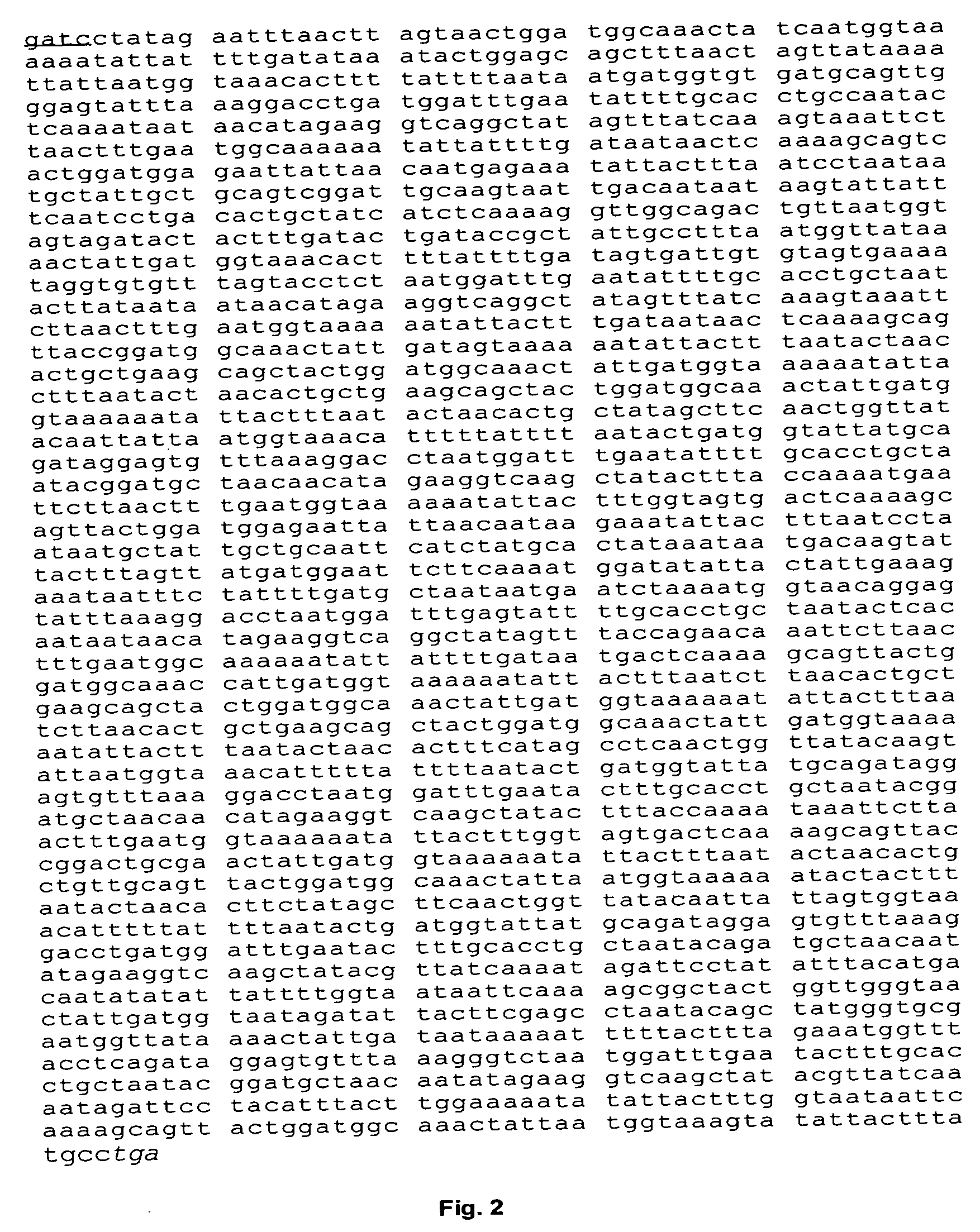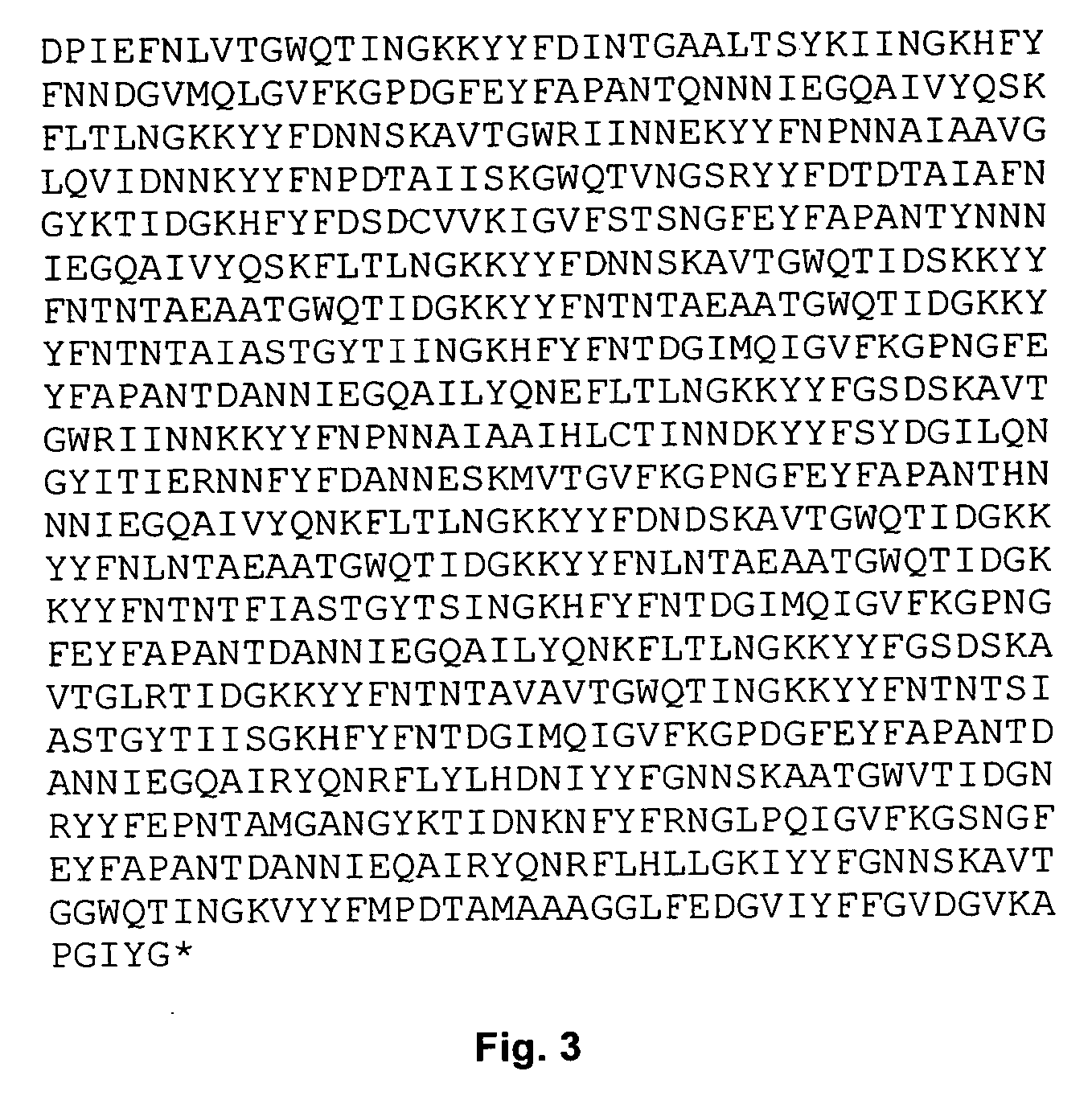Recombinant toxin A and toxin B protein carrier for polysaccharide conjugate vaccines
- Summary
- Abstract
- Description
- Claims
- Application Information
AI Technical Summary
Benefits of technology
Problems solved by technology
Method used
Image
Examples
example 1
Construction of rARU Expression Vector.
[0057] The vector pRSETB-ARU-Kmr used for expression and purification was constructed using standard techniques for cloning (Sambrook et al., Molecular Cloning: A Laboratory Manual (1989)). The nucleotide sequence of the toxin A gene fragment encoding rARU was derived from the cloned toxin A gene (Dove et al., Infect. Immun. 58:480-488 (1990); Phelps et al., Infect Immun. 59:150-153 (1991)) and is shown in FIG. 2. The gene fragment encodes a protein 867 amino acids in length (FIG. 3) with a calculated molecular weight of 98 kDa. The gene fragment was subcloned to the expression vector pRSETB. A kanamycin resistance gene was subsequently subcloned to the vector. The resulting vector pRSETB-ARU-Kmr expresses rARU. An additional 31 amino acids at the N-terminus of the recombinant protein are contributed by the expression vector pRSETB. The final calculated molecular weight of the recombinant protein is 102 kDa.
example 2
Expression and Purification of rARU.
[0058]Escherichia coli T7 expression host strain BL21(DE3) was transformed with pRSETB-ARU-Kmr as described (Sambrook et al. Molecular Cloning: A Laboratory Manual (1989)). One liter cultures were inoculated with 10 ml of overnight growth of Escherichia coli BL21(DE3) containing pRSETB-ARU-Kmr and grown at 37° C. in Terrific broth (Sigma, St. Louis, Mo.) containing 25 μg / ml of kanamycin to an O.D. 600 of 1.8-2.0 and isopropyl B-D-thiogalactopyranoside (IPTG) was added to a final concentration of 40 μM. Cells were harvested after 22 h of induction, suspended in 0.1 liter of standard phosphate buffered saline, pH 7.4, containing 0.2% casamino acids, and disrupted by sonication. Cellular debris was removed from the lysate by centrifugation. Lysates typically contained a titer (reciprocal of the highest dilution with an A450 greater than 0.2) of 106 in the TOX-A test EIA (TechLab, Inc., Blacksburg, Va.). Lysates were saturated with 40% ammonium sulf...
example 3
Synthesis of Polysaccharide-rARU Conjugates.
[0059] Polysaccharides. Pneumococcal type 14 polysaccharide, Lot 40235-001, was manufactured by Lederle Laboratories, Pearl River, N.Y. S. flexneri type 2a O-specific polysaccharide and E. coli K1 polysaccharide were purified as described (Cohen, D. et al. Lancet 349:155-159 (1997); Devi et al. Proc. Natl. Acad. Sci. USA 88:7175-7179 (1991); Schneerson et al. Infect. Immun. 60:3528-3532 (1992)). All preparations had less than 1% protein and nucleic acid.
[0060] Chemicals. 1-ethyl-3-(3-dimethylaminopropyl) carboiimide, (EDC), succinic anhydride, MES (2-[N-morpholino]-thanesulfonic acid) hydrate, 2-[N-morpholino]-ethanesulfonic acid sodium salt), trinitrobenzenesulfonic acid (TNBS) and thimerosal, were from Sigma Co., St. Louis, Mo.; adipic acid dihydrazide, cyanogen bromide and acetonitrile, from Sigma-Aldrich, Milwaukee, Wis.; CL-4b and CL-6B Sepharose, Sephadex G-50, from Pharmacia, Piscataway, N.J.
[0061] Analytical methods. The protei...
PUM
| Property | Measurement | Unit |
|---|---|---|
| Immunogenicity | aaaaa | aaaaa |
Abstract
Description
Claims
Application Information
 Login to View More
Login to View More - R&D
- Intellectual Property
- Life Sciences
- Materials
- Tech Scout
- Unparalleled Data Quality
- Higher Quality Content
- 60% Fewer Hallucinations
Browse by: Latest US Patents, China's latest patents, Technical Efficacy Thesaurus, Application Domain, Technology Topic, Popular Technical Reports.
© 2025 PatSnap. All rights reserved.Legal|Privacy policy|Modern Slavery Act Transparency Statement|Sitemap|About US| Contact US: help@patsnap.com



